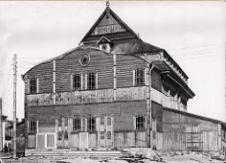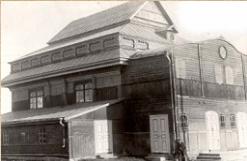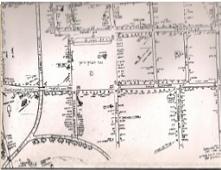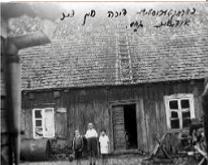VILKAVISKIS
A small town in Southern Lithuania
Where the Jewish Community is no more
Growing Up Under Russian Rule 1815 - 1914 Part 8
RELIGIOUS LIFE
PREPARING FOOD FOR THE SABBATH
Food for Friday evening, Saturday lunch, and the simple meal served before sunset on Saturday had to be prepared before shabes [the Sabbath] began since Jewish law prohibited work on the Sabbath and lighting a fire for cooking was work.
Fridays:
The house became a beehive of activity on Friday. Before sundown, Jews were busy preparing the home to welcome the day of prayer and rest. The khale [braided egg bread] was baked to a golden color and delicate texture. Fish, noodles and the tsholnt [Sabbath stew left to cook on low heat during the previous night] in earthenware pots were prepared. The tsholnt, the hearty Sabbath lunch was often heated in a communal or baker‘s oven sealed with clay, where it remained until Saturday morning. Sometimes the housewife was surprised when her tsholnt got mixed up and that belonging to another family was brought home instead of her meal. To make lokshen [noodles], the housewife rolled the dough into the required thinness, then dried the sheet of dough, often spreading it on the family‘s bedding. Later, she sliced the noodles with a knife.There was a tsimes [vegetable or dessert stew] to cook, heldzlekh [chicken necks] to stuff, and numerous other chores essential for shabes. The rebe [spiritual teacher] began the Jewish Sabbath on Friday afternoon by walking through the market, nodding or blowing a trumpet signaling it was time for the storekeepers to close their doors, for the workmen to lay down their tools, for the drivers to feed and shelter their horses in barns, and for everyone to wash and dress for shabes. The shabes custom to stop work even influenced the non-Jewish storeowners, who also closed their shops because of the lack of Jewish customers. The Jewish men dressed in their shabes wardrobe, usually their finest clothes, they shined their shoes, and often their hair and beards were still wet from a hurried wash because of the short time between work and sundown signifying the Sabbath.
Friday Evening:
Houses of prayer were well lit and only the men attended. At the synagogue on Friday nights, the cantor chanted the kidesh [blessing over wine]. Citizens bade each other ―gut shabes‖ [―Good Sabbath‖] and made certain that poor travelers who stood outside the synagogue door had a place to eat. The men returned to their homes at the end of the service. Inside the windows, hanging lamps and candleholders filled with oil illuminated the houses with shabes spirit. The house was clean and the table was set with two kidesh koyses [ceremonial wine cups]. On the Sabbath and holidays, the head of the family recited the kidesh and led the ritual handwashing. The Sabbath was a soulful time for individuals to praise G-d and express gratitude for life, as well as an inclusive time to remember those who were less fortunate. Bread was a symbolic part of the traditional ritual. Jews blessed the loaves of khale, broke the bread into pieces and passed them around the table. The gefilte fish or herring forshpayz [appetizer] was served. The family sat around the table waiting for the main meal and sang zmires [religious songs to greet the Sabbath], and ―Sholem Aleykhem” [―Peace unto you‖]. The family and guests glowed with contentment from the Sabbath spirit. Worries and tiredness and sad sentiments magically disappeared. The head of the household, the father, read aloud ―Eyshes Khayel” [―Woman of Valor] praising his wife for making the shabes a joyous experience. When the meal was over, the father chanted in Hebrew ―Shir Hashirim” [―Song of Songs]. The mother sweetly sang the melody of the taytsh khumesh [the Yiddish translation of the Torah]. Over time, the candles flickered out, and the kerosene in the hanging lamp slowly extinguished. The house darkened and the family slept peacefully on fraytik bay nakht [Friday night].
The Sabbath:
In Vilkaviskis most Jews lived in the center of town near stores, whereas the Gentiles typically lived farther out. On Saturday mornings, businesses and the marketplace looked deserted because Jewish law prohibited working on Saturdays, and thus stores were closed and no wagons traveled on the roads. Instead, men and women went to synagogue. The learned and wealthy sat at the eastern wall near the Holy Ark and a minyen [quorum of ten adult 29 men] gathered for prayers. During the service, the men walked to the bime [platform for reading Torah] to bless the Torah and read its weekly portion. On the way home from services, usually a child fetched the hot steaming tsholnt from the baker‘s shop. On Saturday afternoons, especially in summers, Jewish children longed to play outdoors. However, the Sabbath was a designated time to study and reflect on the Torah, Talmud, history, and other traditional teachings. The father gathered his children to study the weekly Hebrew portion of ―Pirke-oves” (Hebrew) [―Ethics of our Fathers], and the story, ―Moyshe kibal Toyre mesinay” [Moses brought the Torah from Mount Sinai.] Closing the Sabbath: The father performed havdole [ceremony closing the Sabbath]. He performed the ritual of pouring bronfn [whiskey] over the brim of a cup, which indicated a fule vokh [a blessed ―full‖ week]. Mother recited, ―G-t fun Avromovinu, fun Yitskhek, fun Yankef, der heyliker shabes koydesh geyt avek, s‟zol kumen a vokh fun brokhe, gezunt, un parnose [―G-d of Abraham, Isaac and Jacob, the holy Sabbath goes away, let there come a week of blessings, good health, and livelihood‖]. As the shabes concluded at sundown the concern for kheyune [earning a livelihood] began again.
SACRED PLACES The old synagogue and nearby besmedresh [house of religious study], were surrounded by a fence. Russian state legislation prohibited synagogues from looming higher than churches so architects laid the synagogue foundation lower underground and Jews stepped down into the building. The synagogue building stood tall with small high windows close to the roof and contained a fine towering three-story orn koydesh [holy ark], a cabinet with exquisite wood carvings and gold plating for the Torah scrolls. Beautiful biblical scenes depicting the Holy Land and illustrations of a leopard, eagle, deer and lion on a sky blue ceiling, a mother feeding her children, and other scenes were painted by artists from Warsaw and Odessa on the high ceiling. A centuries-old brass henglaykhter [chandelier], which held hundreds of candles and was revered as an old piece of art, hung from the ceiling.






